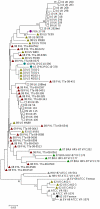Lineages, sub-lineages and variants of enterovirus 68 in recent outbreaks
- PMID: 22536453
- PMCID: PMC3335014
- DOI: 10.1371/journal.pone.0036005
Lineages, sub-lineages and variants of enterovirus 68 in recent outbreaks
Abstract
Enterovirus 68 (EV68) was first isolated in 1962. Very few cases of EV68 infection were described over the ensuing 40 years. However, in the past few years, an increase in severe respiratory tract infections associated with EV68 has been reported. We identified two clusters of EV68 infection in South London, UK, one each in the autumn/winters of 2009 and 2010. Sequence comparison showed significant homology of the UK strains with those from other countries including the Netherlands, Japan and the Philippines, which reported EV68 outbreaks between 2008 and 2010. Phylogenetic analysis of all available VP1 sequences indicated the presence of two modern EV68 lineages. The 2010 UK strains belonged to lineage 2. Lineage 1 could be further divided into two sub-lineages: some Japanese and Dutch strains collected between 2004 and 2010 form a distinct sub-lineages (sub-lineage 1.1), whereas other strains from the UK, Japan, Netherlands and Philippines collected between 2008 and 2010 represent sub-lineage 1.2. The UK 2009 strains together with several Dutch and Japanese strains from 2009/2010 represents one variant (1.2.1), whereas those from the Philippines a second variant (1.2.2). Based on specific deletions and substitutions, we suggest rules for the assignment of lineages and sub-lineages. Molecular epidemiological analysis indicates rapid recent evolution of EV68 and this may explain the recent findings of a global resurgence of EV68. Continuous global monitoring of the clinical and molecular epidemiology of EV68 is recommended.
Conflict of interest statement
Figures





References
-
- Oberste MS, Maher K, Schnurr D, Flemister MR, Lovchik JC, et al. Enterovirus 68 is associated with respiratory illness and shares biological features with both the enteroviruses and the rhinoviruses. J Gen Virol. 2004;85:2577–2584. - PubMed
-
- Khetsuriani N, LaMonte-Fowlkes A, Oberst S, Pallansch MA. Enterovirus surveillance - United States, 1970–2005. MMWR Surveill Summ. 2006;55:1–20. - PubMed
-
- Meijer A, van der Sanden S, Snijders BE, Jaramillo-Gutierrez G, Bont L, et al. Emergence and epidemic occurrence of enterovirus 68 respiratory infections in The Netherlands in 2010. Virology. 2012;423:49–57. - PubMed
-
- Schieble JH, Fox VL, Lennette EH. A probable new human picornavirus associated with respiratory diseases. Am J Epidemiol. 1967;85:297–310. - PubMed
Publication types
MeSH terms
Substances
Associated data
- Actions
- Actions
LinkOut - more resources
Full Text Sources
Miscellaneous

